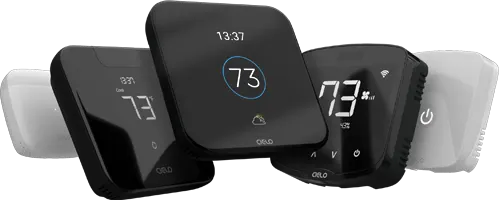Radiant wall heating systems are an energy-efficient solution that keeps your home warm and cozy while staying out of sight.

Key Takeaways
- Radiant wall heating uses panels inside walls to emit infrared heat, warming rooms directly.
- These heating systems are energy-efficient and are ideal for allergy sufferers since it doesn’t circulate air.
- Radiant wall heating is suitable for new builds or renovations.
Radiant heating systems are far from a novel invention. For generations, humanity has harnessed the power of radiation to keep homes warm in freezing temperatures.
Likewise, radiant wall heaters have also been around for quite some time – their efficiency and convenience have been sought after since the 1950s and ’60s. However, as costs soared due to their reliance on electricity, they fell out of favor.
Thanks to recent advancements, they have made a comeback and are now available in energy-efficient types. But before that, let’s cover some basics, like what is radiant wall heating, how does it work, the types of radiant wall heaters and how efficient it is?
- What Is Radiant Wall Heating?
- How Does Radiant Wall Heat Work?
- Why Consider Radiant Wall Heaters?
- Is Radiant Wall Heating Energy Efficient?
- Where To Install Radiant Wall Heating?
- Different Types of Radiant Wall Heaters
- Benefits of Radiant Heating
- Are There Any Drawbacks of Radiant Wall Heating?
- Final Verdict – Is Radiant Wall Heating the Perfect Solution?
What Is Radiant Wall Heating?
The term radiant heating is usually synonymous with radiant floor heating systems. But radiant heat panels that fit in the walls or even the ceiling of your home are now commonplace. Like floor heating systems, these other variants have also garnered praise for providing even heating without being noisy in the least!
These heating systems are pretty straightforward, but they’re slightly different from floor heating systems. Rather than electric cables or pipes, panels made of aluminum are discreetly placed within your walls. These panels efficiently heat up, keeping your home cozy and comfortable.
How Does Radiant Wall Heat Work?
Radiant heat panels generate and deliver heat to their surroundings through radiant heat transfer. This method transfers heat from hot surfaces (such as heated walls) to people and objects via infrared radiation. This heat is similar to the heat you feel when you’re near a hot stovetop, and you feel its warmth.
Like all other systems that work by this principle, radiant wall heating works on a line-of-sight basis. This essentially means that you will be most comfortable when you’re close to the panel and when there are no obstructions between you and the wall.
Why Consider Radiant Wall Heaters?

Since floor heating systems are already widely popular, why not just get one of those for your home? Why should you instead consider radiant wall heating?
While it is true that radiant floor heating is indeed more widespread than wall heating systems, it also happens to be more challenging to install. Floor heating systems consist of an extensive layout of pipes or cables under the floor. You will have to rip out and then replace the entire floor to put these in. That requires an immense amount of labor, time, and of course – money.
Radiant wall heating systems are less intrusive and, therefore, less costly to install. The process involves removing the original drywall, installing the panels, and reinstalling the drywall. These panels aren’t very thick, so they don’t take up much space, and since they’re inside the wall, they aren’t an eyesore.
The radiant heat panels also have the quickest response time of any heating technology. They can also be individually controlled for each room. When combined, these two features make radiant wall heating an excellent choice for saving on heating costs when you have rooms that you don’t frequently use.
Is Radiant Wall Heating Energy Efficient?
The short answer is yes – radiant wall heaters are energy efficient.
However, the level of efficiency depends on various factors like insulation, system design, heat source, zoning, controls, maintenance, building envelope, and energy source. Proper insulation of the walls is crucial to prevent heat loss and maximize efficiency. Implementing zoning can ensure that only the occupied areas are heated, which greatly enhances efficiency. Regular maintenance ensures that the radiant heating system functions optimally and efficiently. The choice of the heat source, such as electricity or gas, and the type of system, such as electric or hydronic, can also have an impact on the cost and efficiency.
Radiant heating is more efficient than baseboard heating and, in some cases, even more efficient than forced-air heating since it eliminates heat loss through ducts. Hydronic radiant heating is particularly more efficient than electric radiant heating. The use of oil, gas, wood-fired boilers, or solar power can significantly influence the overall efficiency of the system.
While electric radiant panels may be more expensive to operate, they offer the advantages of a rapid response time and individual room control. These features result in cost and energy savings when compared to other central heating systems.
Equip your HVAC system with smart features and achieve the perfect balance between comfort & savings.
Learn more
Where To Install Radiant Wall Heating?

If you plan on hanging paintings or other things on the wall, proceed with caution. While this shouldn’t be an issue if the radiant panels are only in the lower four-foot region, you will need to be more careful with taller installations. To avoid puncturing tubes when nailing picture hangers in the wall with the radiant panels, take a picture of the system before putting the finishing drywall in. This will give you a better idea of where the tubes are. You can then mark their location using a tape measure before drilling holes in the wall.
It’s essential to remember that radiant wall heating systems need insulation to prevent heat from leaking to the outside of your home. The extent and type of insulation will depend on where you live, but this is crucial for efficiency.
Can Radiant Panels Be Installed on Ceiling?
You can install radiant heat wall panels on the ceiling, but it should be flat and 8-12 feet high. Also, the panels should be properly insulated to reduce heat loss.
With the radiant ceiling option, you can also use the system in summer by pumping cold water through the tubes. As hot air rises, it will hit the ceiling and then fall back to the ground, creating a convection cooling mechanism. To avoid condensation, it’s best to install a dehumidification system to reduce the moisture content in the air.
Related: Is Radiant Cooling a Good Idea for Your Home?
Different Types of Radiant Wall Heaters
Radiant heating systems come in two primary types – electric systems that radiate heat through wires and hydronic systems that radiate heat through warm water. While some other radiant systems also use air to transfer heat, this method is not standard in radiant wall heating systems.
1. Electric Radiant Wall Heating Systems
Electrical radiant wall heating systems use electric coils that generate heat as electricity passes through them. The metal coils that this system uses resist electricity, and this resistance is what creates heat. This radiant heating system is the most popular, but it’s also pretty costly.
Due to the high costs of electricity, electric radiant wall heating systems are usually added as supplemental heating systems or are run during off-peak electricity usage. Another reason people prefer an electric radiant wall heater is that it requires less maintenance and lasts longer than other radiant heat systems.
2. Hydronic Radiant Heating Systems
Hydronic radiant wall heating systems can be considered hot water wall heaters as they use a boiler to heat water pumped through a network of pipes installed in the wall panels. Since the boiler runs on a fuel other than electricity, this system is cheaper to operate than electric radiant heat systems.
However, hydronic systems come with the danger of pipes leaking or bursting inside your walls, making for an expensive repair.
Benefits of Radiant Heating

Radiant wall heaters are pretty popular around the country and for a good reason. In addition to being efficient and low-cost, these systems have several other benefits that no other system can boast.
Firstly, the radiant heat panels are in direct contact with the walls, so there are no long pathways for the warmth to travel, which can usually result in heat loss along the way. Secondly, radiant wall heating provides you with even and quiet heat, unlike forced air systems. Lastly, since there is no need for ducts or vents to transfer warmth, the heat your home receives is free of allergens, keeping your indoor air quality up to the mark.
Related: Radiant Heat Vs. Forced Air – Which Is the Better Option?
Are There Any Drawbacks of Radiant Wall Heating?
Radiant wall heat systems cost a heavy upfront amount, and in the case of electric radiant heating systems, the operating cost is also very high. On the other hand, while hydronic heating systems have lower running costs, they pose a risk of water leakage. In addition, since this type of heating system is hidden behind the walls, it is difficult to access and repair.
Final Verdict – Is Radiant Wall Heating the Perfect Solution?
Radiant wall heating is indeed an excellent solution for staying warm and cozy all season long. It’s a very efficient system that gives you clean, quiet, and even heating all winter long. A radiant wall heater is also relatively inexpensive to run if you choose to install the hydronic version since gas is cheaper than electricity. So, is this the perfect solution for winter? Yes!









5 Comments. Leave new
I would like to know if the installation of radiant Walls needs to put conducts under the floor.
Great article. Do you offer in-wall radiant heating solutions or can you point to someone in the Unites States who does?
I grew up with radiant heat in the floors and loved it. The community was built in the 1950’s. Big subdivision. Heard that the same group built another subdivision in Virginia. I was in Maryland, few miles soth of DC.
I never heard of an electric version until more recently.
Thanks for your article. I am looking at remodeling and using radiant heating on the 1st floor. I currently have a water furnace, that’s geothermal and they make a 3-way system. That would be forced air heat, AC and radiant.
I love learning about this stuff !!! Have a great holiday….
Do I need to service my wall radiant heat
Radiant wall heating systems do not require heavy maintenance as they do not have filters or ducts.